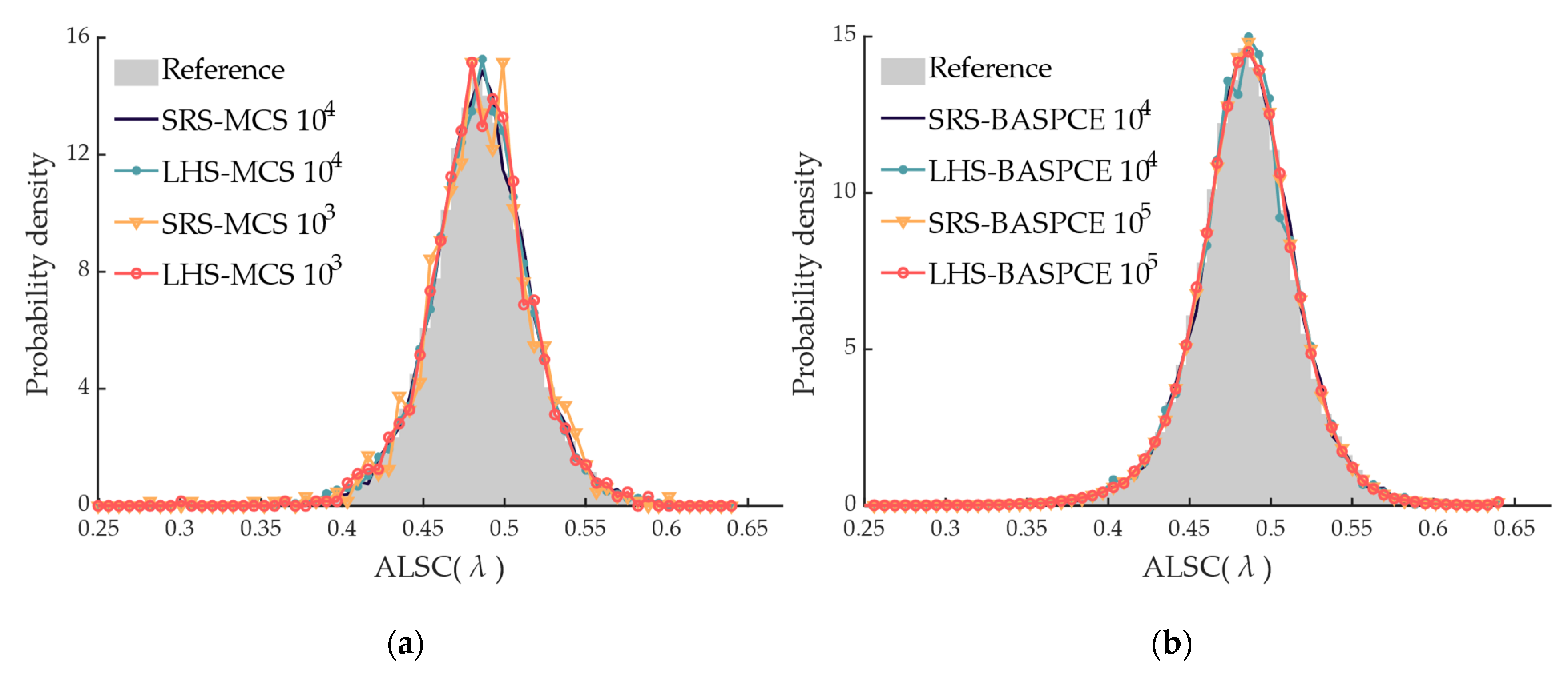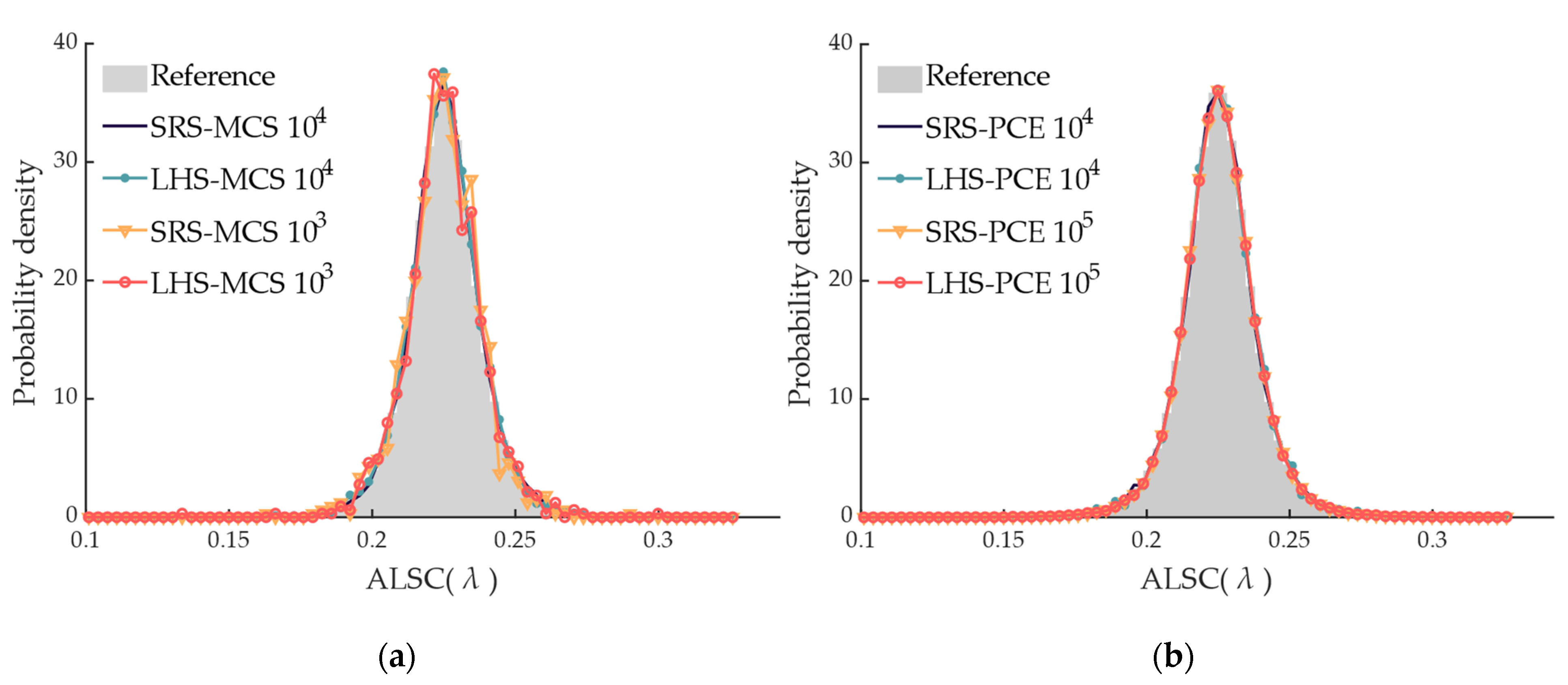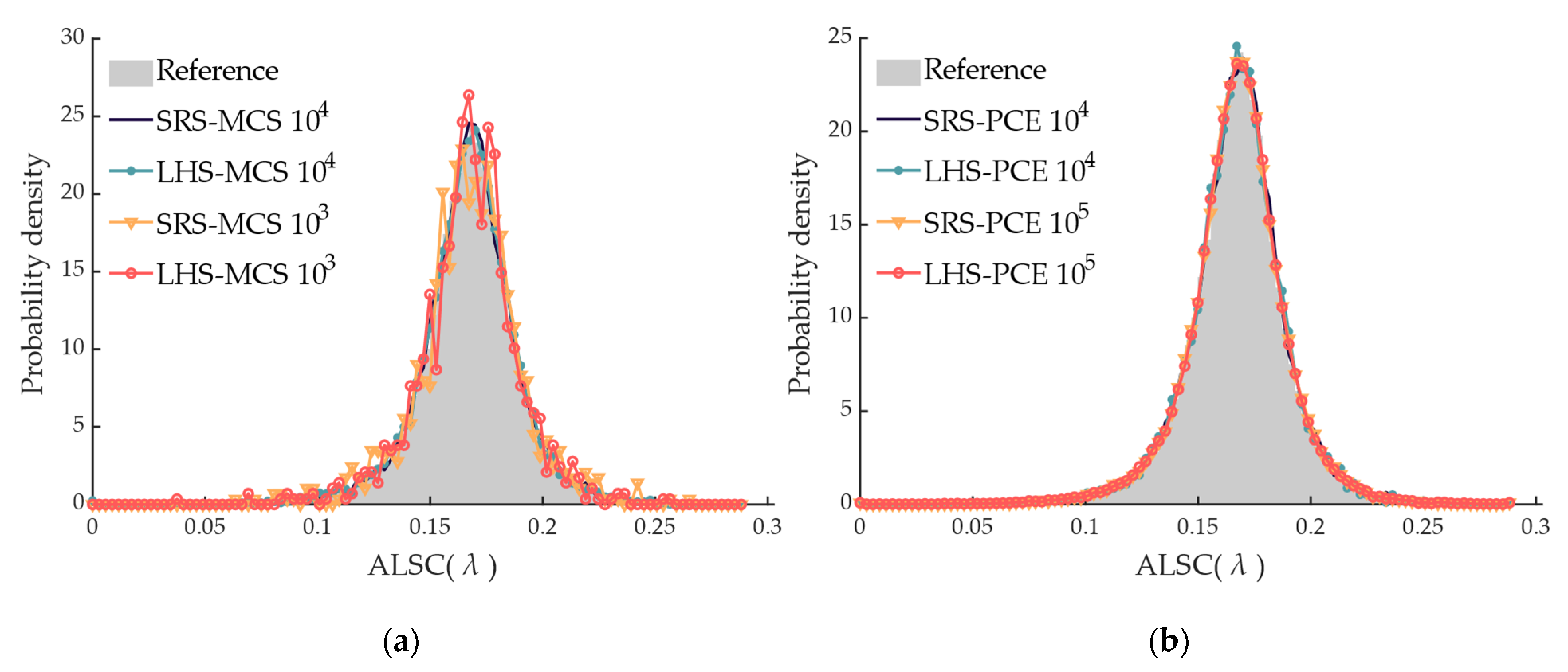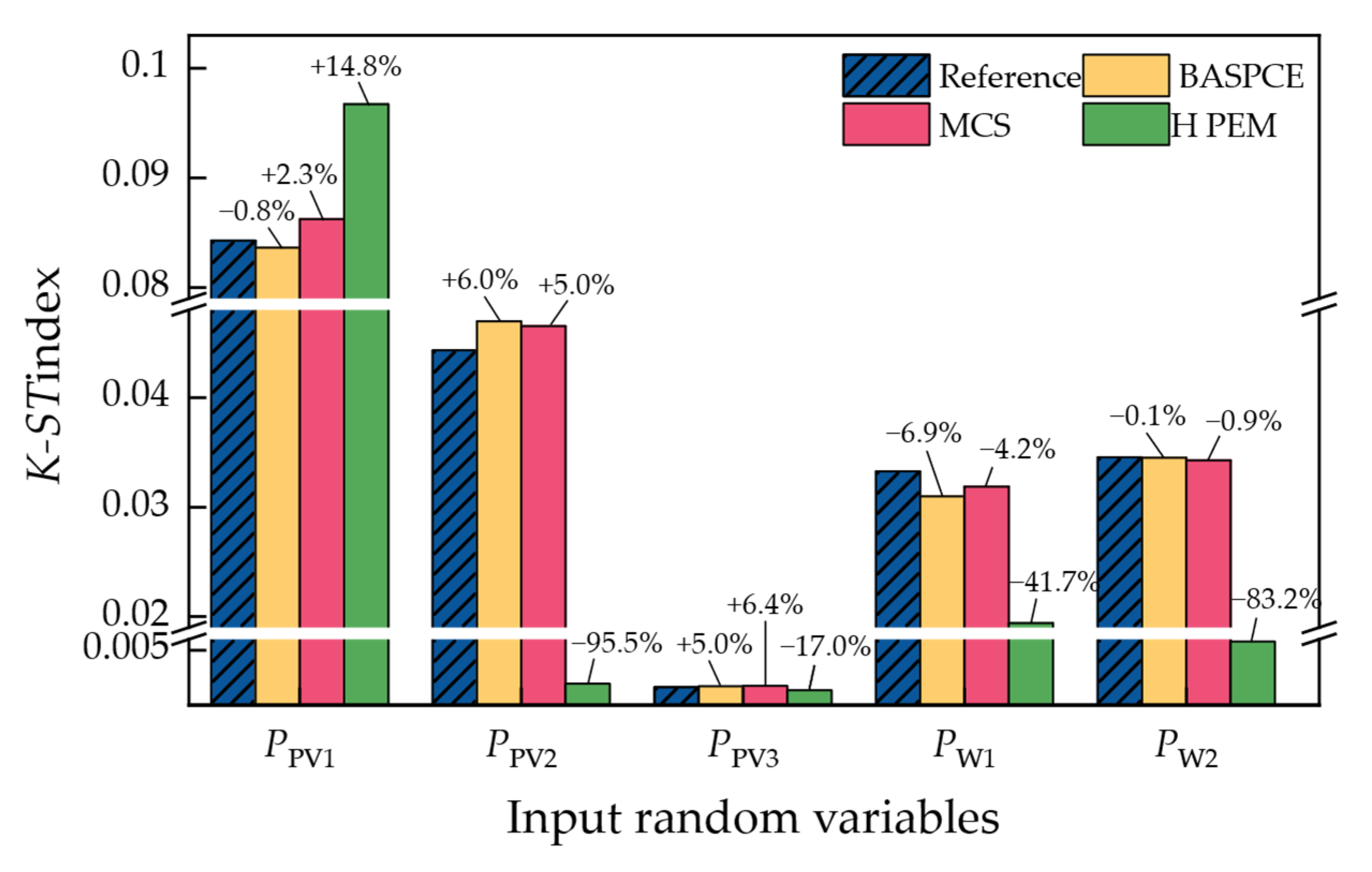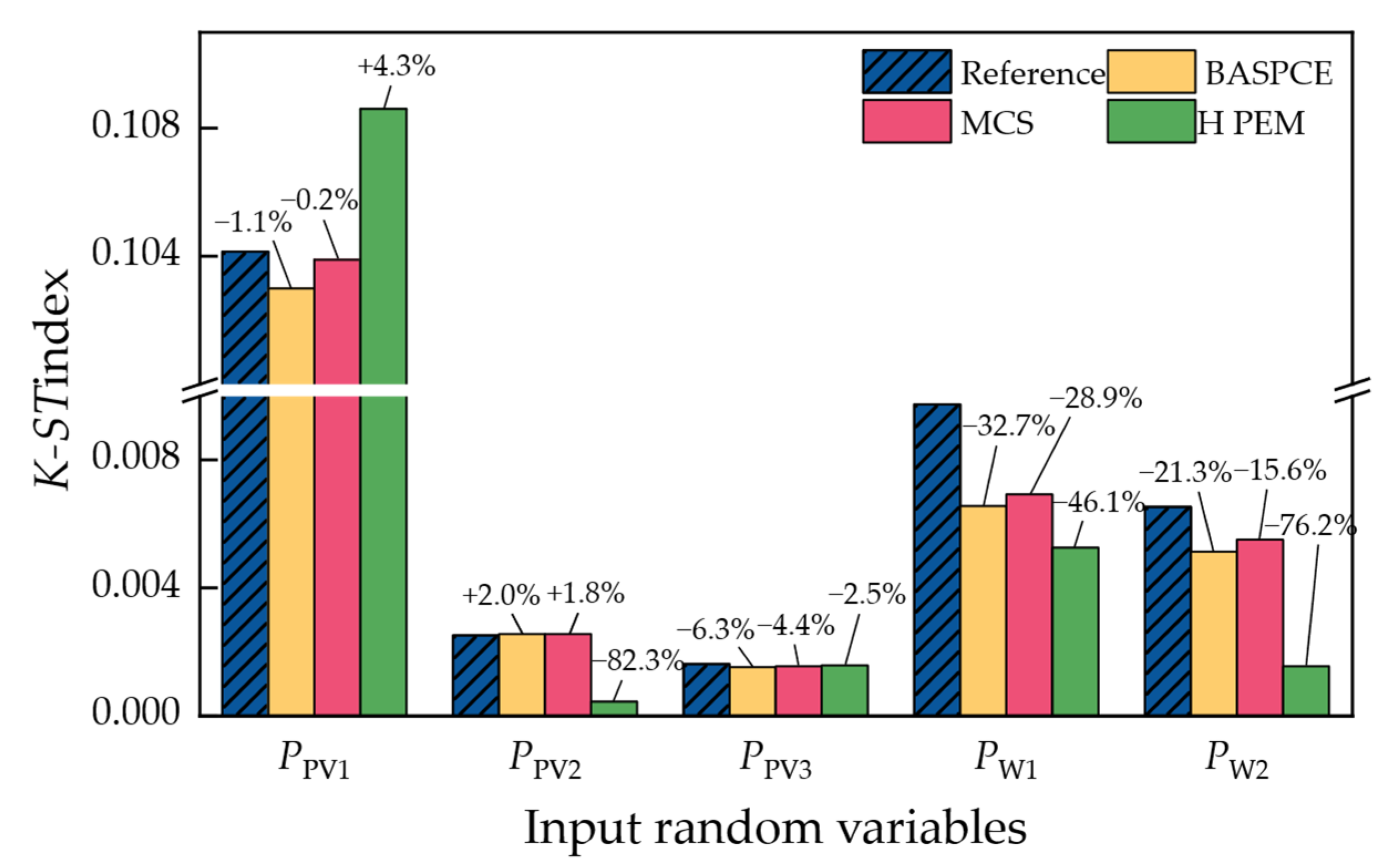1. Introduction
As global attention to environmental protection and sustainable development increases, traditional fossil fuel-based power generation is gradually being replaced by renewable energy sources [
1]. The uncertainty introduced by renewable energy generation significantly impacts the security and stability of power systems [
2,
3]. Load supply capability (LSC) is a crucial aspect of evaluating the security and stability of a power system, as adequate LSC is fundamental to its safe and stable operation [
4]. In this view, it is necessary to study how to quantify the influence of renewable energy generation on LSC, which can provide a reference for the planning of renewable energy installations and the real-time dispatch of renewable energy generation.
Many studies have been conducted on the evaluation of the LSC. However, the terms used in these studies are not consistent [
5]. In order to avoid confusion, a review of the existing works is provided herein. First of all, the term “load capability”, first introduced in 2000, is defined as the maximum percentage load increase given an arbitrary load growth pattern before encountering electrical or operational constraint violations [
6]. In subsequent studies, the concept is also referred to as “available load supply capability (ALSC)” [
4,
7,
8]. More specifically, reference [
4] applied the Latin hypercube sampling-Monte Carlo simulation (LHS-MCS) method for a probabilistic evaluation of ALSC. Reference [
7] studied the impact of power flow entropy on probabilistic ALSC. Reference [
8] combined renewable energy power forecasting with probabilistic ALSC evaluation, achieving probabilistic forecasting of ALSC. Secondly, the term “total supply capability (TSC)”, also called as “power supply capability (PSC)” [
9,
10], was proposed in 2011 by Xiao et al. [
11]. It is defined as the maximum load that a distribution system can provide under the N-1 security criterion. The two main differences between TSC and load capability are that load capability focuses on operational constraints, whereas TSC focuses on N-1 security constraints, and TSC does not specify a load growth pattern. Xiao et al. subsequently conducted a series of studies to supplement and refine the TSC family indices. For instance, reference [
5] improved the ASC index within the TSC family, and reference [
10] examined the TSC evaluation primarily considering user reliability requirements constraints. The third term is “loadability”, which lacks a unified definition and carries different meanings in various studies. For example, reference [
12] defined loadability as a knee or turning point of the power flow solution curve, which can be obtained through a robust two-stage algorithmic framework proposed in the study. In reference [
13], loadability refers to the system’s capability to accommodate added load, and it is derived through an optimization procedure. In reference [
14], loadability is defined as an index calculated based on network parameters and system states.
In summary, despite the different terms used, studies on LSC consistently aim to determine the maximum load the power system can support. The studies vary by considering different decision variables and constraints tailored to specific scenarios and applications. As for solving algorithms, the optimization problem defined by load capability (also referred to as ALSC) is relatively simple and can be solved using the repeated power flow (RPF) method [
4,
8]. On the other hand, the problems involving TSC or loadability without a specified load growth pattern are more complex and often solved using the optimal power flow (OPF) method [
14]. The continuation power flow (CPF) method is frequently used to address loadability problems that account for static voltage stability constraints [
15]. In this paper, ALSC and RPF are chosen because we focus more on operational constraints and computational convenience.
All the above works have made a significant contribution to the evaluation of the LSC. However, there are two main research gaps in the existing studies. The first gap is that no work has studied how to improve the computational efficiency of the probabilistic evaluation of the LSC. In recent years, with the rapid increase in the number of uncertainty sources in power systems, there has been a growing interest in the uncertainty quantification of the LSC evaluation [
4,
7,
8]. As to the authors’ knowledge, most existing works use the simulation methods to calculate the probabilistic RPF (PRPF), which require enormous rounds of deterministic calculations to ensure the convergence. This necessitates significant data storage and computational resources, which are not conducive to real-time grid dispatch and analysis. Therefore, improving the efficiency of probabilistic LSC evaluation is a meaningful but overlooked problem.
Polynomial chaos expansion (PCE) is a commonly used method for enhancing computational efficiency in uncertainty quantification, which has been successfully applied in various fields such as optimal power flow [
16], fault location [
17], and economic dispatch [
18]. The fundamental idea of PCE is to use a set of orthogonal polynomials to approximate the original system model. Basis-adaptive sparse polynomial chaos expansion (BASPCE) is an advanced method that employs the basis-adaptive procedure to automatically select the appropriate truncation strategy and uses a sparse-adaptive scheme to address the curse of dimensionality. Therefore, this paper employs BASPCE to establish a surrogate model for the whole process of the ALSC evaluation to enhance the computational efficiency of probabilistic ALSC evaluation.
The second research gap is that no studies have yet analyzed the impact of renewable energy generation on the system’s LSC. Existing works typically focus on the LSC of the power system or distribution systems, and even though the systems they studied include renewable energy generation, they do not quantify this impact. The inherent uncertainty of renewable energy generation can affect the system’s LSC, making it essential to use specific indices to quantify and evaluate this impact. These indices can also serve as the LSC indices for renewable energy power stations (currently, only the system’s LSC indices exist), providing valuable references for the planning and dispatch of renewable energy generation. In other words, shifting the research focus from the power system to a specific renewable energy power station is highly significant.
Global sensitivity analysis (GSA) is a method capable of analyzing the impact of renewable energy generation on the system’s LSC. This technique measures the influence of input random variables on the probabilistic characteristics of the target output variable [
19,
20]. Specifically, the outputs of renewable energy power stations can be considered as input random variables, and their GSA indices can be computed with respect to the LSC. Based on the results of the GSA indices, the importance of each renewable energy power station can be ranked. In engineering practice, specific operational strategies can be formulated for the controllable equipment of the important renewable energy power stations based on these rankings, thereby enhancing the performance of the LSC.
In general, the research aim of this paper is to study the influence of the uncertainties caused by renewable energy generation on the power system’s LSC. The main innovations and contributions of this paper are summarized as follows:
- (1)
A novel PRPF method is proposed for the probabilistic evaluation of ALSC. This method works based on BASPCE, which can enhance computational efficiency while holding high accuracy.
- (2)
The GSA is introduced systematically into the LSC evaluation to rank the importance of renewable energy power stations in contributing to the system’s LSC.
- (3)
To validate the effectiveness of the proposed method, experiments are conducted on the modified IEEE 39-bus system. Various scenarios are designed to analyze the influence of load growth direction and correlation on the test results.
The framework of this paper is as follows.
Section 2 introduces the probabilistic modeling of uncertainty sources.
Section 3 describes the PRPF method based on BASPCE for the probabilistic evaluation of ALSC.
Section 4 presents the GSA method in the probabilistic evaluation of ALSC. The proposed method is verified on the IEEE 39-bus system in
Section 5, while conclusions are summarized in
Section 6.
6. Conclusions
This paper systematically applies the BASPCE surrogate model to PRPF. Moreover, the GSA based on BASPCE is introduced in the ALSC evaluation to analyze the impact of power stations on the system’s LSC. The test results on the IEEE 39-bus system validate the feasibility and effectiveness of the proposed method. Detailed conclusions are drawn below.
The BASPCE model can efficiently handle RPF with high accuracy and speed for probabilistic ALSC evaluation, as well as GSA based on RPF. More specifically, the distribution of ALSC obtained by the BASPCE is more than 97% similar to the reference. Furthermore, for ALSC evaluation, compared with the PRPF based on the original model, the PRPF based on BASPCE can reduce computation time by approximately tenfold without compromising accuracy. For GSA, since more rounds of MCS are required, the speed advantage of BASPCE becomes more pronounced, thus reducing computation time by over 30 times.
The results of the GSA can quantify the impact of uncertainties in renewable energy stations on LSC, and the ranking derived from GSA indices can assist in identifying the most critical renewable energy power stations.
The limitations of this study mainly lie in two aspects: first, the limitation of the RPF approach. RPF is a simple and effective approach for evaluating ALSC; however, its underlying assumption, a fixed load growth direction, may prevent it from identifying the maximum loading point. Therefore, developing more flexible methods that can account for varying load growth directions represents an important direction for future research.
Second, the limitation of the GSA indices: The GSA indices lack physical interpretability and only provide a relative ranking of influence. Therefore, a promising future direction is to develop a physically meaningful, station-level LSC index.



